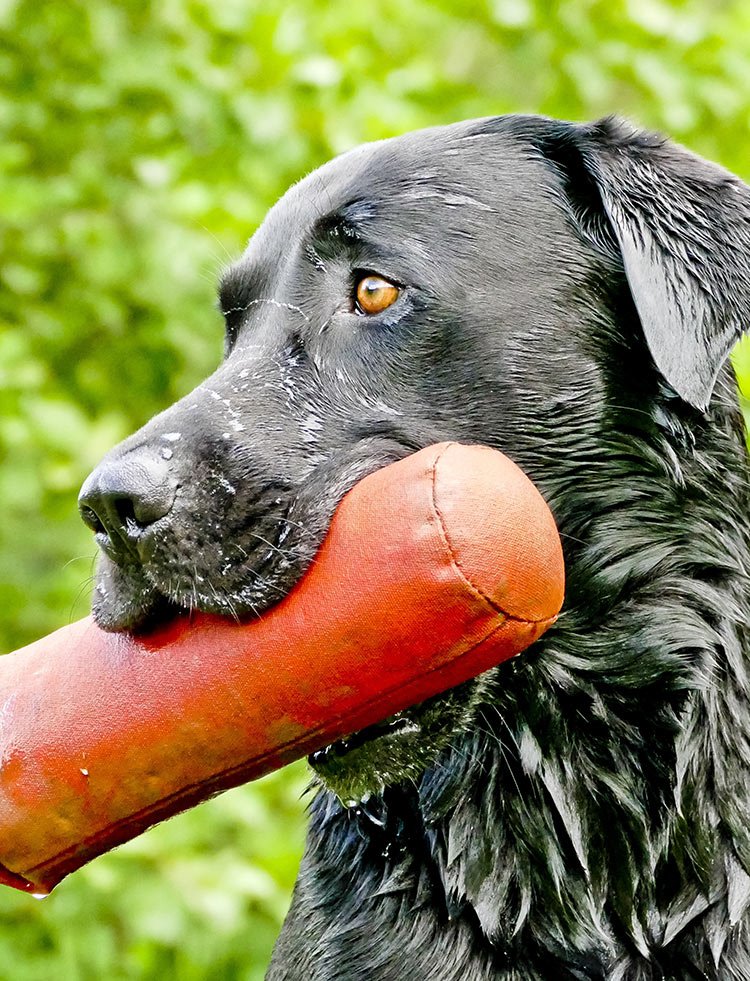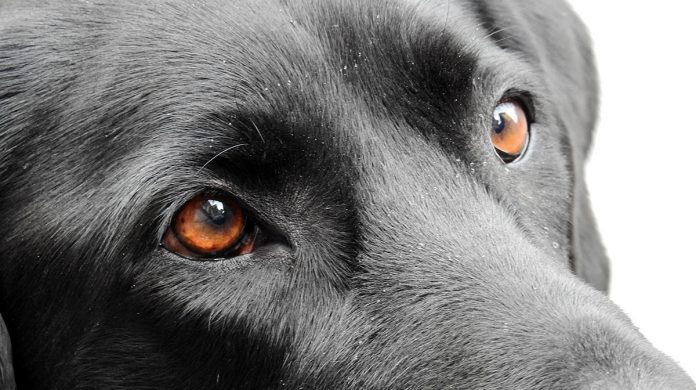Wouldn’t it be fascinating to see the world through your dog’s eyes! Today we are going to answer some popular questions about dog vision. We’ll find out if dogs are color blind, and whether dogs can really see in the dark. We’ll discover how sharp your dog’s eyesight is, and whether he can see better than you. And we’ll look at some of the factors influencing your dog’s vision including advancing age and eye diseases.
How dogs see the world
Not only does your Labrador see the world from much closer to the ground than you (imagine what the world looks like to a Chihuahua!) but his eyes also work in a different way. Both in terms of the position of a dog’s eyes in his skull and the way that his two eyes work together, and in terms of the internal structure of the dog’s eye itself. What your dog sees is not what you see, and vice versa. Let’s start with the fascinating way in which your dog’s eye generates images
How dogs see – inside your dog’s eye
Lining the back of your dog’s eyes, and your own eyes, is a carpet of light sensitive cells or photoreceptors. This carpet is called the retina. The photoreceptive cells of the retina are divided into two different types. Cones which are responsible for color vision, and rods which are responsible for black and white vision. Cones are further divided into different types according to the colors that they are responsible for processing.
The proportion of different types of cells present in the retina determines the way in which we, and our dogs see color.
Are dogs color blind?
I remember being told, as a child, that dogs were color blind. And I think many people grow up believing this to be true. But contrary to popular myth, dogs are not completely colorblind. Your Labrador sees colors differently from the way we do, and his color vision is not as sophisticated as yours. He finds it hard to distinguish between reds and green, but he can see some colors clearly
How do dogs see colors?
Inside the retina are those special light sensitive cells or cones we referred to above. Each type functions as a receptor for a specific wavelength of light. In humans there are three different types. This gives us our excellent trichromatic color vision. Dogs, like many other mammals have just two types of cone (dichromatic vision). And this limits their ability to discriminate some colors.
What colors do dogs see best?
Dogs are effectively red-green color blind. Gun dog trainers use orange retrieving dummies when they want their dogs to use their sense of smell rather than their eyes.

The benefits of dog eyesight
There is a hidden benefit to the poorer color vision that your dog’s eyesight confers. Cones – the color receptors – work best in bright light. Whereas rods – the black and white receptors – are able to function in much lower levels of light. Some of the space in the retina that is occupied by cones in the human eye, is occupied by rods in your dog’s eye. And that’s where night vision comes in
Can dogs see in the dark
Have you ever sat in your yard or garden in the evening and noticed how the colors start to fade with the fading light? That’s because color receptors or cones, don’t function in fading light. So in low light we switch to using the black and white photoreceptors or ‘rods’ in our eyes. And dogs have lots of rods. So in poor light, your dog’s eyesight is more effective than yours.
That doesn’t mean that your dog can see in total darkness, he can’t. In the absence of any light, none of the photoreceptors in your dog’s eyes will work
Do dogs have good night vision
While your dog cannot see in total darkness, provided there is some light, at dawn and dusk for example, or in moonlight, your dog will be able to see much better than you. Not only do they have more rods in their retinas, dogs also have bigger pupils and a light reflecting layer in the back of the eye to make it even more efficient. This is why your Labrador’s eyes may glow when you shine a torch towards his eyes after dark.
Dog’s eyesight compared to humans
Humans with 20/20 vision, have excellent visual acuity. This simply means that we see very sharp and precise images. Dogs on the other hand see a more blurry image, and are more reliant on ‘movement’ to visually locate an object. So, as soon as your dog’s ball stops rolling, unless the color is very obvious to him, your dog will switch to using his far superior sense of smell in order to locate it.
Labradors probably have better visual acuity than some other breeds of dog because they have been bred for generations as retrievers. For the same reasons, field bred Labradors may have even better visual acuity then their show bred cousins.
How else does your dog’s vision differ?
Though your Labrador’s vision in daylight may not be quite as good as yours, it is still very important to him. Because of the way that a dog’s eyes are located in his skull, your dog has somewhat better peripheral vision than you do. He will spot someone sneaking up behind him before a person would. But this comes at a price.
Our forward facing eyes have a significantly overlapping field of vision. This gives us much better depth perception through our stereoscopic vision. It also allows us to shift focus more effectively. Focusing on objects at different distances is call accommodation, and we are much better at this than our dogs.
Many of these advantages are human ones, but remember, when the sun goes down, everything changes! Just like people, dogs are prone to visual problems associated with aging and disease. We need to be aware of the potential for eye problems in our dogs, and to seek veterinary help at an early stage if things are not right.
Eye problems in Labradors
There are eye diseases that Labradors and some other breeds of dog, are particularly susceptible to. These diseases cause a progressive and permanent form of blindness. You can read more about them here: PRA – the fight against blindness. A reputable Labrador breeder tests her breeding stock for these diseases before breeding, and produces puppies that can never develop the more common forms of PRA.
Puppies bred by less responsible breeders are not so fortunate and some will be destined to develop eye problems in mid-life or occasionally even earlier. Widespread health testing is the answer, so do pass the information in those links on to anyone you know that is thinking of buying a Labrador puppy.
Labrador Vision Care
Neglected eye infections or injuries can also lead to blindness, so it is really important to seek help from your vet if you think your dog’s eyes look sore, or if you have any concerns about his vision at all. Just like people, older dogs may develop cataracts and these can be treated.
While dogs on the whole cope pretty well with failing sight, we should not just assume that this is an inevitable consequence of getting old. Drop into your vet if your dog’s eyes look cloudy, or if you think his eyesight is deteriorating.
Dog vision summary
Dog’s can’t see in total darkness but their night vision is better than ours. Labradors and other dogs are not completely color blind but their color vision is less sophisticated than human color vision. These differences have occurred because your dog has become adapted to hunting at dawn and dusk rather than in broad daylight.
Your dog is unlikely to be as sharp eyed as you in full daylight. But with good genes, good care, and a little luck, your dog should be able to enjoy good eyesight throughout his life.
More information on Labradors
If you’d like all of our best Labrador information together in one place, then get your copy of The Labrador Handbook today.

The Labrador Handbook looks at all aspects owning a Labrador, through daily care, to health and training at each stage of their life. The Labrador Handbook is available worldwide. You can buy The Labrador Handbook from Amazon by following this link(paid link). If you do, The Labrador Site will receive a small commission which is greatly appreciated and won’t affect the cost to you!
How does your Labrador see the world was originally published in 2014 and has been extensively revised and updated for 2017
The Labrador Site Founder
Pippa Mattinson is the best selling author of The Happy Puppy Handbook, the Labrador Handbook, Choosing The Perfect Puppy, and Total Recall.
She is also the founder of the Gundog Trust and the Dogsnet Online Training Program
Pippa's online training courses were launched in 2019 and you can find the latest course dates on the Dogsnet website



















I have a 1 yr old lab mix named Izzy. She’s super sweet and fun and spunky. She LOVES to play outside- soccer, Frisby, chase are her favorites. Sometimes she will run full speed into people or objects. I’m not sure if it’s a vision issue or if she’s just not paying attention. She can be clumsy at other times too, and if a person she knows well has something covering their face, she freaks out. Should I be worried? She can catch a Frisby in the air and is very talented at soccer, kind of in a crazy weird cool way. I’ve never seen a dog have actual footwork with a soccer ball. These things make me think her vision is fine. Idk….
I have a 2 1/2 year old Fox Red Labrador called Lucius. He’s really relaxed usually but sometimes he thinks he sees something and will either bark and raise his hackles or run and hide under my chair. I feel like his eyesight might be why he’s acting so strange – he’s done this ever since he was a puppy. Have you ever heard anything like this happening before? He also can’t seem to see people from a distance, he’ll bark and growl even if he knows them and wont stop until they’re at the gate then he suddenly realises who it is and acts all excited like a puppy. Is there something wrong with his eyesight? Or is this normal for some dogs? I have a beagle who is 6 months old and called Pup, and he has no problems like this?
Hi!
I don’t own a lab, I’m just reading your site because it’s so interesting! I’ve spent today reading so many articles, as I absolutely love dogs.
Just thought I’d let you know, that under ‘Do dogs have good night vision’, it says “While you dog cannot see in total darkness” instead of “while YOUR dog cannot see in total darkness”, if you wanted to correct that.
Anyways thank you for an incredible website and I look forward to reading more!
Fixed! Thanks Val for letting us know, glad you like the site. 🙂
My almost 1.5 year old 1/2 chocolate and 1/2 Silver lab is absolutely terrified of enclosed stair cases. It took me 6 months to get him to go up and down the hardwood stairs inside my home. He doesn’t seem to mind them if they are outdoors. I’ve been wondering if it is a depth perception issue. He stares down the stairs like its a giant black hole! Have you heard other people complain about this?
Hi Jodi,
Perhaps past experiences led the dog to associate steps with something unpleasant, frightening and/or hurtful?
Perhaps the dog was yelled at for going up or down a stairway, or had fallen down stairs during his formative weeks, or was pushed down steps. Or the dog recalls that steps once led to a place in which he was frightened, yelled at, or physically abused?
When introducing your pup or dog to steps, work to gradually build her confidence. Start with just approaching the stairway. Reward her for making baby steps – any show of progress, no matter how small. Slowly introduce treats and, of course, verbal reinforcement into the training scenarios. Besides food treats, positive reinforcement tools include playing with your dog and providing a favorite toy for quick romp sessions.
These would be my tips for getting your dog to stop being afraid from taking the stairs. Good luck Jodi!
/Adam – The Lab Coach